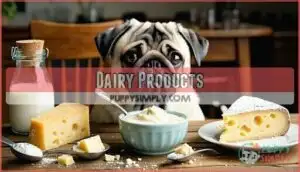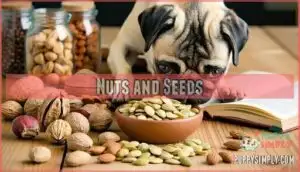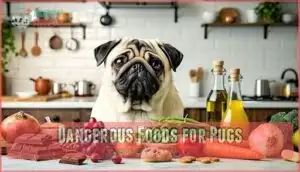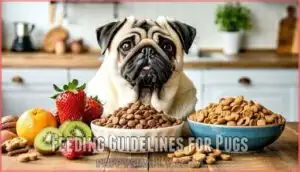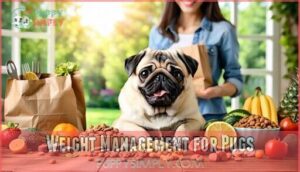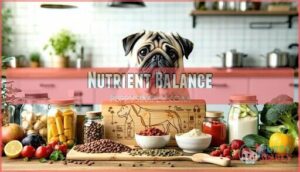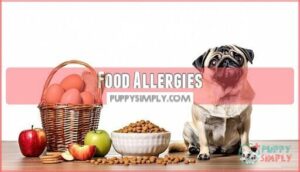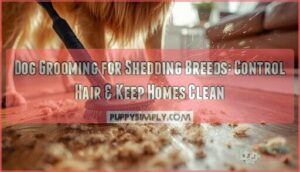This site is supported by our readers. We may earn a commission, at no cost to you, if you purchase through links.
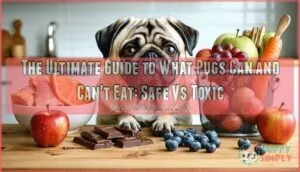
However, chocolate, grapes, onions, and macadamia nuts pose serious health risks and must be avoided completely.
Pugs can enjoy certain vegetables like carrots and sweet potatoes in moderation, but their brachycephalic features require careful portion control to prevent breathing difficulties.
Understanding these dietary boundaries isn’t just about avoiding emergency vet visits—it’s about discovering the secret to your pug’s best health and longevity through strategic nutrition choices.
Table Of Contents
- Key Takeaways
- Foods Safe for Pugs
- Foods to Eat Moderately
- Foods to Generally Avoid
- Dangerous Foods for Pugs
- Feeding Guidelines for Pugs
- Weight Management for Pugs
- Homemade Meals for Pugs
- Health Risks and Vet Care
- Frequently Asked Questions (FAQs)
- What is the best diet for a pug?
- Can a pug eat scrambled eggs?
- What is a pug’s favourite food?
- What food are Pugs most allergic to?
- What is the best diet for a Pug?
- What meat can Pugs eat?
- What Pugs can and can’t eat?
- Can Pugs eat bananas?
- Can Pugs eat chicken and rice?
- Can pugs eat watermelon without seeds?
- Conclusion
Key Takeaways
- You can safely feed your pug lean proteins like chicken and fish, plus fresh fruits such as apples and blueberries – these provide essential nutrients without triggering digestive issues.
- You must completely avoid chocolate, grapes, onions, and macadamia nuts – these foods cause serious toxic reactions that can lead to organ failure or death in pugs.
- You’ll need careful portion control due to your pug’s brachycephalic features – their flat faces make breathing difficult, so proper weight management prevents respiratory complications.
- You should monitor for food allergies when introducing new ingredients – watch for symptoms like itching, vomiting, or diarrhea, and consult your vet for personalized dietary recommendations.
Foods Safe for Pugs
When you’re planning to share safe foods with your pug, you’ll find that many nutritious options can actually benefit their health.
Fresh fruits like apples and blueberries, along with lean proteins and leafy greens, provide essential vitamins and minerals that support your pug’s overall well-being.
Fresh Fruits
Several fresh fruits make excellent treats for your pug’s diet plan. Apples (seedless), blueberries, and bananas provide essential fruit nutrition and berry benefits.
However, avoid citrus fruits like oranges and lemons, which can upset sensitive stomachs. Skip tropical fruits like grapes entirely—they’re toxic foods for pugs.
Watch for fruit allergies and introduce new safe pug foods gradually. This approach helps prevent digestive issues and ensures your pug can enjoy the benefits of fresh fruits like apples.
Leafy Greens
Kale benefits your pug’s health when served in small portions as an occasional treat.
Spinach nutrition provides vitamins A and K, but limit servings due to oxalates.
Include leafy greens in your pug diet plan sparingly – they’re safe pug foods when properly prepared.
Avoid making green smoothies or leafy supplements the foundation of pug eating habits, as moderation prevents digestive upset.
Proteins
Quality Protein Sources form the foundation of your pug’s pug diet plan.
Lean Meat Options like chicken, turkey, and beef provide essential amino acids for muscle development.
Fish Proteins such as salmon and sardines deliver omega-3 fatty acids for coat health.
Egg Whites offer complete proteins without excess fat.
Avoid processed meats with high sodium content, as pug nutrition needs require carefully balanced pug eating habits that support their compact frame and prevent weight gain.
Whole Grains
When choosing whole grains for your pug, brown rice stands out as the gold standard for digestibility and fiber content.
Oat benefits include gentle nutrition that supports your pug’s digestive health, while wheat nutrition varies depending on potential grain allergy concerns.
These grains complement your pug food list by providing essential nutrients that meet pug nutrition needs without triggering pug diet restrictions, supporting pug healthy eating through balanced pug nutrition tips.
Whole grain pasta offers a safe food option that can be a nutritious addition to a pug’s diet when prepared properly, promoting balanced pug nutrition and a healthy diet.
Foods to Eat Moderately
Some foods require careful portion control when sharing with your pug to prevent digestive upset or weight gain.
These moderate foods include dairy products, certain nuts and seeds, and specific meat cuts that can be beneficial in small amounts but problematic in excess, which is why careful management is necessary.
Dairy Products
Most pugs can tolerate small amounts of dairy, but many develop lactose intolerance as adults.
Plain yogurt benefits digestive health through probiotics, while cheese risks include high fat content.
Butter effects include potential weight gain, and it is crucial to monitor your pug for signs of milk allergy like stomach upset or diarrhea after dairy consumption.
Nuts and Seeds
Tread carefully through the nut cracking world of canine nutrition guide—some nuts pose serious risks while others offer benefits.
Many nuts contain high fat content that challenges pug digestive health, potentially triggering pug allergy symptoms or digestive upset.
Consider these moderate options:
- Sunflower seeds (unsalted, shelled) – safe healthy pug snacks in small amounts
- Chia benefits include omega-3s when sprinkled sparingly on food
- Peanut allergy risks require careful monitoring for reactions
- Seed toxicity varies—avoid macadamia nuts completely
Always prioritize pug dietary needs over treats.
Limited Meats
Certain meats require careful consideration in your pug’s diet. Raw meat poses bacterial risks, while cooked chicken provides excellent protein when prepared properly. Beef strips should be lean and unseasoned to prevent digestive upset.
| Meat Type | Safety Level |
|---|---|
| Raw Meat | High Risk |
| Cooked Chicken | Safe (boneless) |
| Beef Strips | Moderate (lean only) |
| Fish Oil | Beneficial |
| Lamb Chops | Occasional treat |
Understanding pug nutrition guide principles helps you make informed decisions about protein sources. Your pug’s dietary needs vary based on age and activity level. A thorough canine nutrition guide emphasizes moderation with fatty meats.
Effective pug meal planning incorporates diverse protein sources while monitoring for pug food allergies that may develop over time.
Foods to Generally Avoid
Some foods pose serious health risks to your pug and should be completely avoided to prevent poisoning or severe illness.
Understanding these dangerous substances can help you protect your furry friend from accidental ingestion and potentially life-threatening complications, which is crucial for the health and wellbeing of your furry friend.
Chocolate Hazards
Unfortunately, chocolate represents one of the most serious Dog Chocolate threats to your pug’s health.
Theobromine Effects create severe Toxic Reactions because pugs metabolize this compound poorly.
Dark chocolate contains dangerous levels causing Chocolate Poisoning within hours. Even small amounts trigger Cocoa Toxicity, leading to vomiting, elevated heart rate, and potentially fatal seizures requiring immediate veterinary intervention.
Caffeine Risks
Keep your pug away from coffee, tea, and energy drinks – caffeine toxicity poses serious stimulant risks to their cardiovascular and nervous systems.
While antioxidants in tea benefit humans by reducing oxidative stress and supporting mitochondria, pugs can’t process caffeine safely.
Coffee hazards include rapid heart rate, seizures, and potentially fatal tea overdose symptoms, highlighting the importance of dog food safety.
Stick to your pug feeding schedule with dog food safety as priority.
Toxic Substances
Beyond caffeine, numerous household items pose serious health risks.
Your pug’s curious nature makes toxic exposure a real concern, as their small size amplifies poisoning effects.
- Toxic Foods – Xylitol sweetener causes rapid blood sugar drops and liver failure
- Poisonous Plants – Azaleas, tulips, and sago palms trigger severe gastrointestinal distress
- Hazardous Chemicals – Cleaning products contain compounds causing respiratory issues and burns
- Deadly Substances – Antifreeze’s sweet taste masks lethal ethylene glycol toxicity
Dangerous Foods for Pugs
While most foods pose manageable risks to your pug, certain items can trigger severe toxic reactions that require immediate veterinary intervention.
These dangerous substances can cause symptoms ranging from gastrointestinal distress to organ failure, making prevention your most critical defense against potentially life-threatening emergencies.
Macadamia Nuts
Macadamia nuts rank among the most dangerous treats for your pug. These seemingly innocent nuts contain unknown compounds that trigger severe toxicity levels in dogs within 3-12 hours of ingestion. Just one nut per 2.2 pounds of body weight can cause vomiting, weakness, tremors, and fever – creating serious digestive issues that outweigh any antioxidant benefits these nuts might offer humans.
One tiny macadamia nut can poison your pug within hours—prevention beats treatment every time.
It’s essential to understand the risks of macadamia nut toxicity to prevent harm to your pet.
| Symptom | Onset Time | Severity |
|---|---|---|
| Vomiting | 3-12 hours | Moderate |
| Hind limb weakness | 6-12 hours | Severe |
| Tremors/shaking | 8-24 hours | High |
| Fever | 12-24 hours | Moderate |
| Ataxia (loss of coordination) | 6-18 hours | Severe |
Unlike other nuts that might cause minor stomach upset, macadamias specifically target your pug’s nervous system, creating oxidative stress that affects mobility and coordination. While no fatalities have been reported, the temporary paralysis and constant shaking cause significant distress.
Recovery typically occurs within 48 hours, but prevention remains your best strategy – keep all macadamia-containing foods away from curious pug noses.
Avocado Pit
Avocado flesh offers antioxidant benefits, but the pit poses serious choking hazards for pugs.
Pet safety demands complete pit removal before offering any avocado. The large, hard pit can obstruct airways or cause gastrointestinal disorders if swallowed.
Avocado toxicity primarily stems from persin, though pits contain higher concentrations.
Skip avocado entirely for pug meal ideas and choose safer pug treat options to prevent oxidative stress complications.
Understanding the risks of cyanide poisoning factors is vital for responsible pet ownership and avoiding similar dangers.
Grapes and Raisins
Grapes and raisins represent some of the most dangerous fruits for pugs, causing severe grape poisoning and raisin toxicity even in small amounts.
Unlike other fruit allergies that cause mild gastrointestinal disorders, these toxic effects trigger acute kidney failure through unknown mechanisms.
Canine reactions include vomiting, lethargy, and oxidative stress damage. Never offer grapes as pug treat options despite their antioxidant properties—safer pug meal ideas exclude all grape products entirely.
Feeding Guidelines for Pugs
Establishing proper feeding guidelines guarantees your pug maintains prime health while avoiding nutritional imbalances that can lead to obesity or digestive issues.
You’ll need to examine meal frequency, portion control, and treat selection to create a sustainable feeding routine that supports your pug’s unique dietary requirements.
Meal Frequency
Proper feeding schedules substantially impact your pug’s energy and gastrointestinal health.
Adult pugs require two meals daily, spaced eight to twelve hours apart for ideal nutrient intake.
This meal timing prevents overeating and supports steady stamina throughout the day.
Puppies need three to four smaller portions to accommodate their developing digestive systems.
Consistent eating habits reduce risks of diarrhea and nausea while promoting healthy portion control.
Healthy Treats
Why settle for ordinary treats when you can offer your pug Fresh Rewards that boost their health?
Nutritious Bites containing omega3 polyunsaturated fatty acids support energy and stamina while providing antioxidant properties your furry friend needs.
- Fruit Pieces: Apple slices, blueberries, and banana chunks deliver natural vitamins
- Healthy Snacks: Carrot sticks and sweet potato cubes satisfy cravings safely
- Dog Cookies: Homemade oat-based treats control ingredients and portions
- Protein bites: Plain cooked chicken or fish provides essential nutrients
Reputable Food Brands
When selecting pet food for your pug, veterinarians consistently recommend brands like Royal Canin, Hill’s Science Diet, and Purina Pro Plan for their rigorous food safety protocols and nutrition facts transparency.
These companies conduct thorough ingredient quality testing, ensuring ideal omega3 and polyunsaturated fatty acids levels.
Look for formulations containing fish oil or krill oil rather than synthetic supplements like Lovaza, which benefit your pug’s skin and coat health through proper brand reviews.
It’s also essential to think about pug dog nutrition when making decisions about your pet’s diet, considering complete concepts of nutrition for optimal health.
Weight Management for Pugs
Maintaining your pug’s ideal weight requires consistent monitoring and smart dietary choices to prevent obesity-related health complications.
You’ll need to balance calorie intake with appropriate exercise while tracking your dog’s body condition score to guarantee healthy well-being throughout their life, ensuring a long and healthy life.
Monitoring Weight
Regular weight checks prevent obesity-related complications like hyperglycemia and high triglycerides in pugs.
Monitor your pug’s body condition weekly, feeling for rib coverage under a thin fat layer. Track calorie intake through measured food portions and limit healthy snacks to 10% of daily calories.
Proper weight control supports gastrointestinal health and prevents metabolic disorders.
Obesity prevention requires consistent monitoring and portion adjustments.
Exercise Routine
Beyond tracking your pug’s weight, establishing consistent Daily Walks creates the foundation for healthy weight management.
Pugs thrive on routine, requiring 30-40 minutes of moderate activity split into shorter sessions to accommodate their breathing limitations.
Your pug’s Exercise Routine should include:
- Morning and evening walks – Two 15-minute sessions prevent overexertion
- Indoor Play Time – Puzzle games and gentle fetch on extreme weather days
- Supervised swimming – Low-impact activity that protects joints while building Fitness Levels
- Brief Outdoor Runs – Short bursts in cool weather with constant monitoring for breathing distress
Understanding proper growth plate care is essential for preventing injuries in pugs.
Balanced Diet
A balanced diet forms the cornerstone of effective weight management for your pug.
Calculate proper calorie intake based on your dog’s age, weight, and activity level.
Meal planning should emphasize lean proteins, vegetables, and limited carbohydrates while incorporating polyunsaturated fatty acids for cardiovascular health.
Monitor your pug’s energy levels and gastrointestinal responses to dietary changes, adjusting feeding schedules to meet their specific nutritional needs.
Homemade Meals for Pugs
Making homemade meals for your pug requires careful attention to nutritional balance and ingredient safety.
You’ll need to verify proper protein, carbohydrate, and fat ratios while avoiding common allergens that can trigger digestive issues or skin problems in this sensitive breed, ensuring complete concepts of nutrition are considered.
Nutrient Balance
Creating homemade meals requires careful attention to your pug’s vitamin needs and mineral intake.
Without proper caloric balance, even well-intentioned meals can harm your dog’s health.
Macronutrients must work together—proteins support cellular energy through ATP production in mitochondria, while dietary fiber aids digestion.
Polyunsaturated fatty acids provide essential energy your pug can’t produce alone.
A balanced diet is essential, and understanding pug food recipe basics is essential for their health.
Consider these nutritional realities:
- Missing B-vitamins can cause irreversible nerve damage in your beloved companion
- Calcium deficiency leads to painful bone fractures that could have been prevented
- Unbalanced phosphorus ratios create lifelong skeletal deformities affecting mobility
Meal Preparation
Proper meal planning transforms kitchen chaos into organized nutrition for your pug. Start cooking methods with gentle steaming or boiling—never frying or adding seasonings. Food safety requires washing hands, sanitizing surfaces, and storing prepared meals in refrigerated portions within two hours.
| Preparation Step | Best Practice | Safety Tip |
|---|---|---|
| Ingredient Prep | Wash all produce thoroughly | Remove seeds, pits, stems |
| Cooking Method | Steam or boil proteins | No oils, spices, or salt |
| Portion Control | Measure based on pug’s weight | Use kitchen scale for accuracy |
| Storage | Refrigerate within 2 hours | Label with preparation date |
| Serving | Room temperature portions | Check temperature before serving |
Nutrient ratio balance demands precise measurements—typically 50% protein, 25% vegetables, 25% grains for ideal health. Understanding dog food nutrition is vital for creating a well-balanced diet for your pet.
Food Allergies
Food allergies in pugs can range from mild Food Intolerance to severe anaphylaxis.
Watch for Allergy Symptoms like itching, vomiting, or diarrhea when introducing new ingredients.
Skin Issues and Digestive Problems often signal hypersensitivity to proteins like chicken or beef.
Document any Allergic Reactions immediately—swelling or breathing difficulties require emergency veterinary care.
Common allergens include dairy, wheat, and certain proteins.
Always introduce single ingredients gradually to identify triggers and monitor for Allergic Reactions.
Health Risks and Vet Care
Even the most careful pug parent can face unexpected health emergencies when their furry friend gets into something they shouldn’t have eaten.
Recognizing the warning signs of bloat and knowing when to rush to the emergency vet can mean the difference between a minor scare and a life-threatening situation.
Bloat Risk
Gastric dilation-volvulus threatens pugs when they gulp food too quickly, swallowing air that causes dangerous stomach expansion.
Quick gulping turns mealtime into a medical emergency—slow feeding saves pug lives.
This gastrointestinal emergency progresses rapidly, creating severe abdominal pain and digestive health complications.
Unlike simple gastroenteritis or gastroesophageal reflux disease, bloat requires immediate veterinary intervention.
Prevent this life-threatening condition by feeding smaller, frequent meals and avoiding post-meal exercise to maintain ideal gastrointestinal function.
Emergency Vet Visits
When gastrointestinal symptoms like vomiting, diarrhea, or abdominal pain persist beyond twelve hours, seek urgent care immediately.
Vet emergencies involving pet poisoning require swift emergency response—don’t wait for symptoms to worsen.
Allergic reactions can escalate rapidly, making animal first aid knowledge essential. Trust your instincts; you know your pug best.
Having basic pet first aid skills is essential in emergency situations.
Frequently Asked Questions (FAQs)
What is the best diet for a pug?
You’ll want to feed your pug high-quality dog food with balanced protein, healthy fats, and controlled portions.
Avoid chocolate, grapes, onions, and garlic—they’re toxic.
Choose smaller kibble for easier breathing.
Can a pug eat scrambled eggs?
Like a sunny morning breakfast that brightens your pug’s day, scrambled eggs offer excellent protein and essential nutrients.
You can safely feed your pug plain scrambled eggs in moderation, but avoid butter, salt, or seasonings that could upset their sensitive digestive system.
What is a pug’s favourite food?
Your pug doesn’t have one favorite food, but they’ll go crazy for high-value treats like chicken, sweet potato, or plain rice.
Every pug’s taste buds differ, so observe what makes their tail wag most enthusiastically during mealtime.
What food are Pugs most allergic to?
Taking your breath away like dust from a beloved toy, proteins trigger most allergic reactions in dogs, particularly beef, chicken, dairy, and wheat gluten.
You’ll find these everyday proteins can unexpectedly turn against your pug’s sensitive system, causing persistent discomfort.
What is the best diet for a Pug?
High-quality protein sources like chicken, fish, and lean beef should form your pug’s dietary foundation. You’ll need portion control since pugs gain weight easily, affecting their breathing and joints substantially.
What meat can Pugs eat?
You can safely feed your pug lean beef, chicken, turkey, and lamb.
Remove bones, excess fat, and seasoning before serving.
These protein sources support muscle development and provide essential nutrients for your pug’s health.
What Pugs can and can’t eat?
What’s the golden rule for feeding your furry friend?
You can give pugs lean chicken, turkey, beef, and fish, plus fruits like apples and blueberries.
Never feed chocolate, grapes, onions, or xylitol-containing foods—they’re toxic and dangerous for your pug’s health.
Can Pugs eat bananas?
You can safely give your pug bananas as an occasional treat.
They’re packed with potassium and vitamins, but their natural sugars mean moderation is key—small pieces work best for your furry friend.
Can Pugs eat chicken and rice?
An ounce of prevention is worth a pound of cure."
Yes, you can safely feed your pug chicken and rice.
This bland combination provides digestible protein and carbohydrates, making it ideal for upset stomachs or regular meals when properly prepared without seasoning, as it is a pound of cure.
Can pugs eat watermelon without seeds?
Yes, you can feed your pug seedless watermelon as an occasional treat.
The flesh provides hydration and vitamins while being low in calories.
Remove all seeds and rind first, as these can cause digestive upset or blockages in small dogs, especially due to the potential for blockages.
Conclusion
Before telegraphs transformed communication forever, responsible pet ownership required careful attention to dietary choices.
Following the ultimate guide to what pugs can and can’t eat guarantees your companion’s peak health and longevity.
Remember that safe foods like lean proteins, fresh fruits, and vegetables provide essential nutrients, while toxic substances such as chocolate, grapes, and macadamia nuts require complete avoidance.
Monitor portion sizes carefully due to pugs’ brachycephalic anatomy and weight management needs.
Always consult your veterinarian for personalized dietary recommendations and emergency guidance.
- https://evangersdogfood.com/nutritional-tips-for-pugs/
- https://www.reddit.com/r/pugs/comments/1cd1zeg/what_food_andor_vegetable_that_you_give_your/
- https://www.akc.org/expert-advice/nutrition/fruits-vegetables-dogs-can-and-cant-eat/
- https://www.youtube.com/watch?v=gyUuGO6duHk
- https://furloved.co/blogs/news/complete-guide-to-pug-dog-food

